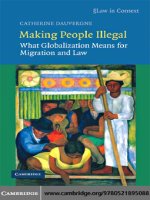0521873177 cambridge university press making treaties work human rights environment and arms control apr 2007
Bạn đang xem bản rút gọn của tài liệu. Xem và tải ngay bản đầy đủ của tài liệu tại đây (1.78 MB, 465 trang )
This page intentionally left blank
M A K I N G T R E AT I E S WO R K
There is an increasing focus on the need for national implementation of
treaties. International law has traditionally left enforcement to the individual parties, but more and more treaties contain arrangements to
induce States to comply with their commitments. This book examines
three forms of such mechanisms: dispute settlement procedures in the
form of international courts, non-compliance procedures of an administrative character, and enforcement of obligation by coercive means.
Three fields are examined, namely, human rights, international environmental law, and arms control and disarmament. These areas are in
the forefront of the development of current international law and deal
with multilateral, rather than purely bilateral issues. The three sections
of the book on human rights, international environmental law and
arms control contain a general introduction and three or four case
studies of the most relevant treaties in the field. The book finishes with
three concluding articles.
is Professor of Law and Director of the Norwegian
Centre for Human Rights, University of Oslo.
is Professor of Public Law, International Law and
European Law at the Justus-Liebig-Universität Gießen, and a Research
Fellow at the University of Luzern.
is Professor of Law and Director of the
Walter-Schücking-Institute for International Law, University of Kiel.
M A K I N G T R E AT I E S WO R K
Human Rights, Environment and Arms Control
Edited by
GEIR ULFSTEIN
in collaboration with
T H I LO M A R AU H N and
ANDREAS ZIMMERMANN
CAMBRIDGE UNIVERSITY PRESS
Cambridge, New York, Melbourne, Madrid, Cape Town, Singapore, São Paulo
Cambridge University Press
The Edinburgh Building, Cambridge CB2 8RU, UK
Published in the United States of America by Cambridge University Press, New York
www.cambridge.org
Information on this title: www.cambridge.org/9780521873178
© Cambridge University Press 2007
This publication is in copyright. Subject to statutory exception and to the provision of
relevant collective licensing agreements, no reproduction of any part may take place
without the written permission of Cambridge University Press.
First published in print format 2007
eBook (EBL)
ISBN-13 978-0-511-27806-8
ISBN-10 0-511-27806-3
eBook (EBL)
ISBN-13
ISBN-10
hardback
978-0-521-87317-8
hardback
0-521-87317-7
Cambridge University Press has no responsibility for the persistence or accuracy of urls
for external or third-party internet websites referred to in this publication, and does not
guarantee that any content on such websites is, or will remain, accurate or appropriate.
CONTENTS
Preface and acknowledgments
Notes on the contributors
Table of cases
Table of treaties and other international instruments
page xi
xiii
xvi
xix
INTRODUCTION
Introduction
,
The significance of treaties
Compliance with treaty obligations
General international law
Treaty mechanisms
Dispute settlement procedures
Non-compliance procedures
Enforcement
The structure of the book
PART I
3
3
4
5
6
7
9
11
12
INTERNATIONAL HUMAN RIGHTS
1 Dispute resolution, compliance control and
enforcement in human rights law
1.1 General questions and introduction
1.2 Dispute resolution
1.3 Compliance control
1.4 Enforcement
1.5 Overall evaluation
v
15
15
16
22
38
47
vi
2 The International Covenant on Civil and Political Rights
2.1 General issues
2.2 Dispute resolution
2.3 Compliance control
2.4 Enforcement
2.5 Overall evaluation
3 The European Convention on Human Rights
.
3.1 Introduction
3.2 The Court and its procedures
3.3 The Court’s judgments
3.4 Overall evaluation
4 The European Convention on the Prevention of Torture
compared with the United Nations Convention Against
Torture and its Optional Protocol
4.1 General issues
4.2 Defining the task
4.3 Dispute resolution
4.4 Compliance control
4.5 Enforcement
4.6 Overall evaluation
PART II
48
48
53
57
64
66
70
70
74
80
87
91
91
101
103
104
107
109
INTERNATIONAL ENVIRONMENTAL LAW
5 Dispute resolution, compliance control and
enforcement in international environmental law
5.1 Introduction
5.2 Dispute settlement procedures
5.3 Compliance control
5.4 Enforcement
5.5 Overall evaluation
115
115
118
124
128
131
6 The Convention on International Trade in Endangered
Species of Wild Fauna and Flora (CITES)
6.1 Introduction
6.2 Compliance control
6.3 Enforcement
6.4 Effectiveness of the compliance and
enforcement mechanisms
6.5 Dispute resolution
6.6 Lessons learned
7 The Convention on Long-Range Transboundary Air Pollution
7.1 General
7.2 Dispute resolution
7.3 Compliance control
7.4 Enforcement
7.5 Overall evaluation
Annex: Structure and Functions of the
Implementation Committee and Procedures
for Review of Compliance
8 The Convention on Access to Information, Public
Participation in Decision-Making and Access to Justice
in Environmental Matters (Aarhus Convention)
8.1 Introduction
8.2 Summary contents of the Aarhus Convention
and the nature of the Convention
8.3 Dispute resolution
8.4 Rules of the Convention and MoP decisions on
reporting and compliance control
8.5 Bodies responsible for monitoring compliance
8.6 Procedures of the Compliance Committee
8.7 Determination of non-compliance and decision
on non-compliance response measures
8.8 The relationship between settlement of disputes
and review of compliance
vii
134
134
136
148
152
157
158
161
161
165
166
172
173
175
179
179
182
183
189
192
197
203
213
viii
8.9 Do the compliance and the dispute settlement
mechanisms constitute a self-contained regime?
8.10 Overall evaluation
9 The Convention on Environmental Impact Assessment
in a Transboundary Context (Espoo Convention)
9.1 Dispute resolution
9.2 Compliance control
9.3 Overall evaluation
PART III
214
215
218
220
226
235
INTERNATIONAL ARMS CONTROL
10 Dispute resolution, compliance control and
enforcement of international arms control law
10.1 Introduction
10.2 Consolidation rather than crisis?
10.3 Negative and positive incentives to comply with
arms control agreements
10.4 Dispute settlement in arms control agreements
10.5 Compliance control in arms control agreements:
verification and inspections
10.6 Enforcement
10.7 Perspectives
11 The Convention on the Prohibition of the Development,
Production, Stockpiling and Use of Chemical Weapons and
on their Destruction (Chemical Weapons Convention)
11.1 Introduction
11.2 Dispute resolution
11.3 Compliance control
11.4 Enforcement
11.5 Overall evaluation
11.6 Conclusion
243
243
247
250
255
257
266
271
273
273
274
279
290
298
300
12 The Treaty on the Non-Proliferation of Nuclear Weapons (NPT)
and the IAEA Safeguards Agreements
12.1 The IAEA’s safeguards system
12.2 The Treaty on the Non-Proliferation
of Nuclear Weapons
12.3 Comprehensive NPT Safeguards Agreements
12.4 Verification
12.5 Dispute resolution
12.6 Compliance
12.7 Enforcement
12.8 Overall evaluation
13 The Convention on the Prohibition of the Use, Stockpiling,
Production and Transfer of Anti-Personnel Mines and on their
Destruction (Ottawa Convention)
13.1 Negotiating history of the Ottawa Convention
13.2 Key obligations, achievements and challenges
13.3 Compliance control, dispute resolution and enforcement
mechanisms managed by the States parties
13.4 The involvement of non-State actors in
compliance control
13.5 Conclusions: assessing the strengths and
weaknesses of the Ottawa Convention’s
compliance control regime
ix
301
302
304
306
308
312
314
319
321
324
325
327
329
341
343
GENERAL COMMENTS
14 Dispute resolution
.
14.1 Dispute settlement in a fragmented legal order
14.2 International human rights
14.3 Environment
14.4 Arms control
14.5 Conclusion
351
351
356
362
365
368
x
15 Compliance control
15.1 Reporting
15.2 Monitoring and assessment of compliance
15.3 Compliance bodies
15.4 Outcomes
15.5 Conclusion
16 Enforcement
.
16.1 Terminology and basic distinctions
16.2 Enforcement in the different treaty systems
16.3 The role of State responsibility
373
319
396
407
Index
411
374
376
380
388
390
391
PREFACE AND ACKNOWLED GMENTS
This book is the outcome of a joint research project undertaken by the
editors. The underlying theme was to analyze how various regulatory
regimes can facilitate the implementation of relevant treaty obligations
undertaken by States parties. The editors had decided to invite specialists
working in three fields of international law, namely, human rights, international environmental law and arms control, in order to provide analyses of
arrangements for dispute settlement, compliance control and enforcement.
These contributions were supplemented by introductions from the editors
and concluding chapters by well-known academics.
Thilo Marauhn and Geir Ulfstein applied for financing from the
Deutsche Forschungsgemeinschaft (German Research Foundation) and
the Norwegian Research Council, respectively, and the editors are grateful to both these institutions for the support they provided which made this
endeavour a reality. Drafts of the respective reports were presented and
discussed at a workshop held at the Walther-Schücking-Institute for
International Law, University of Kiel, from 20 to 23 January 2005, which
Andreas Zimmermann had undertaken to organize. Geir Ulfstein secured
the contact with the authors and the publisher with a view to finalizing
the book.
The editors would like to thank particularly all the contributors for
their dedication, for allocating their precious time to this project, and for
the open discussions during the workshop. We would like to give our
special appreciation to Sarah Isabelle Reich, Justus Liebig University,
Gießen, for her support in preparing the application to the Deutsche
Forschungsgemeinschaft, to the staff of the Walther-Schücking-Institute,
in particular Carmen Thies, for having organized the workshop in such a
professional manner, and, finally, the scientific assistants, Janne Kaasin,
Karin Kaasen and Andreas M. Kravik, for their great efforts and skills in
making the manuscript ready for publication.
xi
xii
Finally, thanks go to Cambridge University Press and its staff, first and
foremost Finola O’Sullivan who ever since we first approached her has been
an effective decision-maker.
NOTES ON THE CONTRIBUTORS
Jutta Brunnée is Professor of Law and Metcalf Chair in Environmental
Law, University of Toronto.
Renate Kicker is Associate Professor at the Institute of International Law
and International Relations, University of Graz, Austria; a Member of the
European Committee for the Prevention of Torture and Inhuman or
Degrading Treatment or Punishment (CPT) since September 1997; and
Director of the European Training and Research Centre for Human Rights
and Democracy (ETC).
Veit Koester was a civil servant with the Danish Ministry of Environment
until 2002. He is External Professor at Roskilde University Centre,
Denmark, and Visiting Professor at United Nations University’s Institute of
Advanced Studies, Yokohama, Japan and a guest lecturer at Copenhagen
University, Faculty of Law. He is chairman of the Compliance Committee
of the Aarhus Convention and chairman of the Compliance Committee of
the Cartagena Protocol on Biosafety. He is a member of the Steering
Committee for the IUCN (the World Conservation Union) Commission
on Environmental Law and a member of the Conseil Europeen du Droit de
l’Environnement (CEDE).
Timo Koivurova is Research Professor of Arctic Environment and
Minority Law, and Director of the Northern Institute for Environmental
and Minority Law (NIEM/Arctic Centre).
Tuomas Kuokkanen is Counsellor, Ministry of Environment of Finland;
was a member of the Implementation Committee under the Convention
on Long-Range Transboundary Air Pollution from 1999 to 2005; and is a
xiii
xiv
part-time Professor of International Environmental Law at the University
of Joensuu.
Kathleen Lawand is Legal Adviser, Mines-Arms Unit, International
Committee of the Red Cross (ICRC).
Thilo Marauhn is Professor of Public Law, International Law and
European Law at the Justus-Liebig-Universität Gießen, and Research
Fellow at the University of Luzern.
Andreas Paulus is Lecturer, Institute for International Law, LudwigMaximilians-University München, Germany.
Rosalind Reeve is Associate Fellow of the Sustainable Development
Programme, Chatham House, UK, and adviser to the David Shepherd
Wildlife Foundation and the International Fund for Animal Welfare.
Laura Rockwood is Principal Legal Officer, Section Head for NonProliferation and Policy Making, Office of Legal Affairs, International
Atomic Energy Agency.
Martin Scheinin is Professor of Constitutional and International Law and
Director of the Institute for Human Rights at Åbo Akademi University,
Turku, Finland. He was a member of the Human Rights Committee from
1997 to 2004.
Lisa Tabassi is Legal Officer, Technical Secretariat of the Organisation for
the Prohibition of Chemical Weapons (OPCW).
Christian J. Tams is Lecturer, Walther-Schücking-Institute
International Law, University of Kiel, Germany.
for
Geir Ulfstein is Professor of Law and Director of the Norwegian Centre for
Human Rights, University of Oslo. He is Deputy Director of the Board,
Norwegian Branch of the International Law Association. He is also a
member of the International Law Association’s Committee on Human
Rights Law and Practice, and a member of the IUCN (the World
Conservation Union) Commission on Environmental Law.
xv
Mark Villiger is a Judge of the European Court of Human Rights, and is
Titularprofessor of International and European Law at the University of
Zurich.
Andreas Zimmermann is Professor of Law and Director of the WalterSchücking-Institute for International Law, University of Kiel. From 1999 to
2001 he was a member of the expert commission for the drafting of a Code
of Offences Against International Law at the German Ministry of Justice. In
1997/8 he was a member of and legal adviser to the German delegation at
the Preparatory Committee for, and at the United Nations Diplomatic
Conference of Plenipotentiaries on, the Establishment of an International
Criminal Court.
TABLE OF CASES
Permanent Court of International Justice
Mavrommatis Palestine Concessions Case (Greece v. United Kingdom), 1924 255,
352
International Court of Justice
Application of the Convention on the Prevention and Punishment of the Crime of
Genocide (Bosnia and Herzegovina v. Yugoslavia), 1996 18
Application of the Convention on the Prevention and Punishment of the Crime of
Genocide (Croatia v. Yugoslavia), 2002 18
Armed Activities on the Territory of the Congo (Democratic Republic of the Congo v.
Rwanda), 2002 18
Avena and Other Mexican Nationals (Mexico v. United States), 2004 354, 357, 359
Barcelona Traction, Light and Power Company Ltd (Belgium v. Spain), 1970 39, 354,
364
Case Concerning Armed Activities on the Territory of the Congo (Democratic
Republic of the Congo v. Uganda), 2005 43
Certain Property (Liechtenstein v. Germany), 2005 352, 353, 355
East Timor (Portugal v. Australia), 1995, 90 352, 354, 364
Fisheries Jurisdiction Case (Spain v. Canada) 1998 371
Gabcikovo–Nagymaros Dam case (Hungary v. Slovakia), 1997 119, 362, 363
LaGrand (Germany v. US), 2001 354, 357
Land and Maritime Boundary between Cameroon and Nigeria (Cameroon v. Nigeria),
1998 352
Legal Consequences of the Construction of a Wall in the Occupied Palestinian
Territory, Advisory Opinion, 2004 42, 54, 353, 354, 360
Legality of the Threat or Use of Nuclear Weapons, Advisory Opinion, 1996 54, 252,
355, 360, 363, 367, 368
Questions of Interpretation and Application of the 1971 Montreal Convention arising
from the Aerial Incident at Lockerbie (Libya v. UK), 1998 352, 372
South West Africa Cases, 1962 255
Vienna Convention on Consular Relations (Paraguay v. US), 1998 371
xvii
Arbitration
Behring Sea Fur Seals Arbitration, Moore’s International Arbitration Awards 755, 1898
119
Lake Lanoux case, 24 ILM 101, 1957 119
MOX Case: Dispute Concerning Access to Information under Article 9 of the Ospar
Convention (Ireland v. United Kingdom), Permanent Court of Arbitration,
2003 120, 384
Southern Bluefin Tuna Arbitration, 39 ILM 1359, 2000 119
Trail Smelter (US v. Canada), 3 UNRIAA 1905 (1941); (1939) 33 AJIL 182 119, 362
WTO Dispute Settlement Body
EC – Asbestos: European Communities – Measures Affecting Asbestos-Containing
Products, 2001, WT/DS135/AB/R 361, 370
EC – Bananas: Report of the Appellate Body on the European Community Regime for
the Importation, Sale and Distribution of Bananas, 1997, WT/DS27/AB/R 354
US – Shrimps: United States – Importation of Certain Shrimp and Shrimp Products,
1998, WT/DS58/AB/R 361
US – Steel: United States – Imposition of Countervailing Duties on Certain HotRolled Lead and Bismuth Carbon Steel Products Originating in the United
Kingdom, 2000, WT/DS/138/AB/R 361
International Labour Organization Administrative Tribunal
Judgment 2032 (2001)
Judgment 2232 (2003)
Judgment 2256 (2003)
Judgment 2327 (2004)
Judgment 2328 (2004)
278
279
278
279
279
UN Human Rights CommitteeReports
A v. Australia, 1993 64
Apirana Mahuika et al. v. New Zealand, 1984 61
Bernard Ominayak, Chief of the Lubicon Lake Band v. Canada, 1984 49, 60, 61
Dante Piandiong et al. v. Philippines, 1999 63
A Publication and a Printing Company v. Trinidad and Tobago, 1989 60
European Commission on Human Rights
Austria v. Italy, 1961 18
Denmark, Norway, Sweden and the Netherlands v. Greece, 1968 22
xviii
European Court of Human Rights
Akkoc v. Turkey, 1993 106
Amuur v. France, 1996 104
Austria v. Italy, Application, 1960 79
Belilos v. Switzerland, 1988 80
Broniowski v. Poland, Application, 1996 83
Brumarescu v. Romania, Application, 1995 83
Corigliano v. Italy, 1982 81
Cyprus v. Turkey, 2001 22, 79
Denmark, Norway, Sweden and the Netherlands v. Greece, 1967 79
France, Norway, Denmark and Sweden v. Turkey, 1982 79
Gençel v. Turkey, Application, 1999 83
Ilascu v. Moldova and Russia, Application, 1999 82
Ireland v. United Kingdom, 1978 22, 79
Kalashnikov v. Russia, 2002 106
Le Compte, Van Leuven and de Meyere v. Belgium, 1982 82
Lorsé v. Netherlands, 2001 106
Mamatkulov v. Abdurasulovic v. Turkey, Applications, 1999 72
Moreira de Azevedo v. Portugal, 1991 81
Tyrer v. United Kingdom, 1978 88
Van der Ven v. Netherlands, 2003 106
X etc. v. Netherlands, 1984 73
Inter-American Court of Human Rights
Advisory Opinion, 1999 359
Barrios Altos Case, 2003 27
Netherlands
LJN: AU8685, Rechtbank ’s-Gravenhage, 09/751003-04 298
United Kingdom Privy Council
Tangiora v. Wellington District Legal Services Committee (2000) 4 LRC 44 45
TABLE OF TREATIES AND OTHER INTERNATIONAL
INSTRUMENTS
General Instruments
1945 UN Charter
art. 2(3) 353
art. 2(4) 267
art. 33 7, 255, 353
art. 39 269, 270, 304, 406
art. 41 270
art. 42 270
art. 48 304
art. 53 392
art. 96 354
Chapter VII 251, 266, 295–6, 297, 304
1945 ICJ Statute
art. 36(1) 17
art. 36(2) 17
art. 63(2) 123
1963 Vienna Convention on Consular Relations, 596 UNTS 291 4, 371
art. 36 357
1969 Vienna Convention on the Law of Treaties, 1155 UNTS 331 46
art. 3 207
art. 28 76
art. 31 44
art. 31(3)(a) 233
art. 60 5, 129, 212, 214, 393
art. 60(1)(a)(i) 85
art. 60(2)(c) 122, 269, 409
art. 60(5) 212, 214
xix
xx
1998 Statute of the International Criminal Court (Rome Statute), 2187 UNTS 3 298,
358
art. 12 359
art. 13 359
2001 Articles on State Responsibility 5
art. 33(2) 39
art. 41 42
art. 42 6, 42, 122, 409
art. 42(11) 364
art. 42(b)(ii) 409
art. 48 6, 42, 409
art. 48(1) 408
art. 48(7) 364, 365, 409
art. 49 6, 42, 43
art. 54 6, 42, 43, 408
General regional instruments
1948 Charter of the Organization of American States, 119 UNTS 3
art. 9 46
1948 Statute of the Council of Europe
art. 3 23, 24, 85
art. 4 23
art. 7 31, 85
art. 8 31, 46, 85, 109
art. 23(a) 31
1972 European Convention on State Immunity, ETS No. 074A
Additional Protocol 1972 89
art. 1 89
art. 2 89
art. 4 89
2000 Constitutive Act of the African Union, OAU Doc. CAB/LEG/23.15
art. 30 46
2000 Cotonou Agreement [2000] OJ L317/3 403
art. 9 402
art. 96(2) 402
xxi
Human rights
1948 Convention on the Prevention and Punishment of the Crime of Genocide, 78
UNTS 177
art. IX 17
1948 Universal Declaration of Human Rights, UN Doc. A/810 (1948) 71 15, 48, 88
art. 3 97
1950 European Convention for the Protection of Human Rights and Fundamental
Freedoms, ETS No. 5 15, 70–90, 384
art. 3 77, 93, 105, 110, 396
art. 6(1) 83
art. 8 77
art. 10 77
art. 11 77
art. 15 45
art. 19 74
art. 21 74
art. 22 74
art. 23 75
art. 24 37
art. 25 75
art. 26 76
art. 28 75, 76
art. 29 75
art. 30 72, 75
art. 33 79, 407
art. 34 76, 78, 79
art. 35 77
art. 35(2)(b) 17, 76
art. 35(3) 76, 77
art. 36(3) 87
art. 37(1)(a) 75
art. 38(1)(b) 78
art. 39 78
art. 40 78
art. 41 81, 82, 83
art. 45 78
art. 46 80
art. 46(1) 33, 71, 80
art. 46(2) 33, 71, 84, 85, 400
art. 46(3) 86
xxii
art. 46(4) 87
art. 52 26
art. 54 33
art. 55 41
art. 59(2) 74
Protocol 1, art. 1 83
Protocol 11 17, 70, 80
Protocol 12 70–1
Protocol 14 34, 72, 74, 76, 77, 80, 86–7
art. 8(2) 34
1960 Unesco Convention Against Discrimination, 429 UNTS 93
art. 17 25
1966 Convention on the Elimination of All Forms of Racial Discrimination (CERD),
660 UNTS 195
art. 9 25
art. 11 20
Optional Protocol 68
1966 International Covenant on Civil and Political Rights (ICCPR), 999 UNTS 171
15, 48–69, 89, 375, 376, 377, 380, 381, 382, 384
art. 1 48, 49
art. 2 50, 65
art. 2(3) 51
art. 3 50
art. 4 45
art. 6 48, 49
art. 7 49, 97, 396
art. 8 49
art. 9 49, 64
art. 10 48–9
art. 11 49
art. 12 49
art. 13 49
art. 14 49
art. 15 49
art. 16 49
art. 17 49
art. 18 49
art. 19 49
art. 20 49
xxiii
art. 21 49
art. 22 48
art. 23 49
art. 24 49
art. 25 48
art. 26 48
art. 27 48, 50
art. 28 19, 50, 52, 64, 126
art. 29 126
art. 30(4) 52
art. 31 19
art. 39(2) 53, 64
art. 40 25, 50, 52, 53, 64, 65
art. 40(1) 51, 57
art. 40(2) 51, 57
art. 40(4) 53
art. 41 17, 20, 50, 51, 54, 55, 56, 407
art. 41(1) 19, 20
art. 42 50, 51, 54, 55, 56
art. 42(6)(c) 52
art. 44 18, 54
Protocol 1 on Individual Complaints 49, 50, 52, 63–4, 68
art. 4 19
art. 4(2) 62
art. 5(1) 56, 62
art. 5(3) 62
art. 5(4) 20, 52, 63
art. 5(a) 199
1966 International Covenant on Economic, Social and Cultural Rights (ICESCR), 993
UNTS 3 15, 47, 48
art. 16 25
1969 American Convention on Human Rights, 1144 UNTS 123 89
art. 26 28
art. 27 45
arts. 34–40 19
art. 34 19
art. 35 19
art. 41(f) 36
art. 42 28
art. 43 28









